Warszawa II (2 page)
Authors: Norbert Bacyk


In reality, at the beginning of July, Model had only succeeded in forming a couple of new divisions with units from other nearby Heeresgruppe forces. With these troops, primarily from the 4th Panzer-Division, the 5th Panzer-Division and the 28th Jäger-Division from Ukrania, but also drawn from the 12th Panzer-Division and the 170th Infantrie-Division from Latvia, Model launched the first counter-offensive west of Minsk. The fighting spilled quickly over into Lithuanian territory and thanks to the new tactical units; the German field marshal began to throw back the Soviet advances effectively. After successes at Vilnius and Grodno, the attacks of the 2nd and 3rd Belorussian Fronts were strongly limited. In order to reorganise the left and inner-centre flanks of Heeregruppe “Mitte” (the right flank occupied by the 2nd Army still remained passive at the original positions they had occupied prior to the Soviet offensive) the Germans were forced to pay for it (the reorganization itself) at the cost of seriously weakening the nearby Heeresgruppe forces, particularly along the Ukrainian front. A further negative facet of hastily sending new or insufficiently re-organised divisions was that they went into battle as weak and poorly coordinated units. An additional problem was the slow pace at which the forces along the front could be reinforced. The reason for this was the great distance that units from Romania, Italy and even Norway (196th Infanterie-Division) or Holland (19th Panzer-Division) were forced to cover. Transport problems were aggravated by air attacks, partisan attacks, and finally, by the altered situation at the front. Sometimes, only isolated regiments arrived at vulnerable locations, while the rest of the divisions were stuck at railway yards or were caught up in fighting somewhere else and found themselves in an emergency situation. As a result of this, throughout the first half of July, Model could only employ a portion of the promised reinforcements. Only fifteen divisions were in place at the appointed time in western Belorussia. When the other combat forces eventually arrived at the front; those that had been sent into battle a couple of weeks before had paid heavily in terms of their combat strength. Additional divisions drawn from the Reserve Army did not begin to participate in the fighting until the end of July and on into August.
Soviet assault-guns SU-76M from an unidentified unit entering the liberated city of CheÅm Lubelski in July 1944. (WAF)
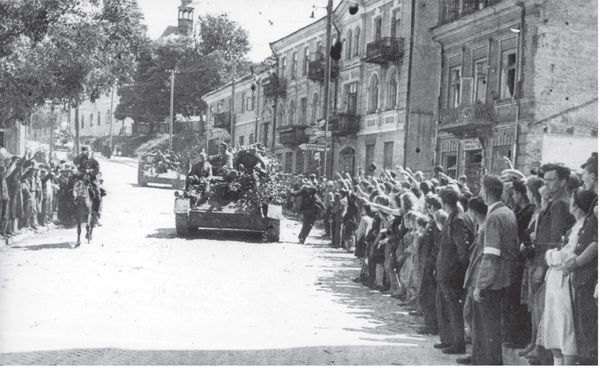
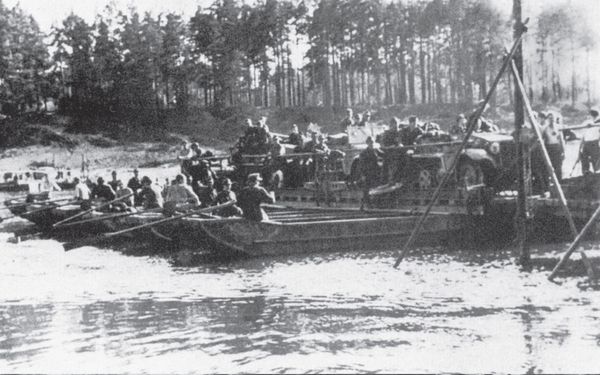
German units retreating across one of Poland's many rivers on a ferry. In all likelihood, a headquarter staff is being transported across, judging by the limousine and staff-car on the ferry. (Leandoer & Ekholm archive)
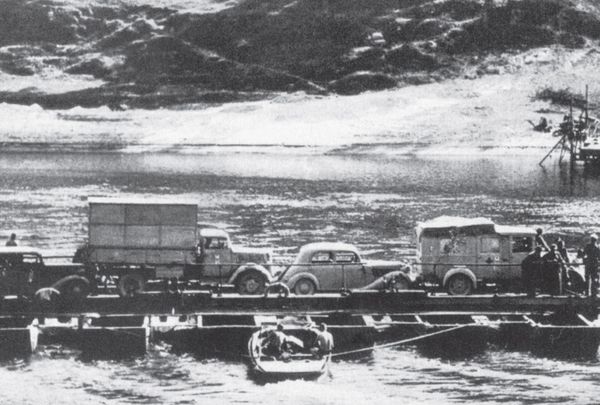
German units cross a river in Poland in the summer of 1944 while retreating from advancing Soviet forces. Note the half-track-tractor Sd Kfz 10 at the centre of the picture. (Leandoer & Ekholm archive)
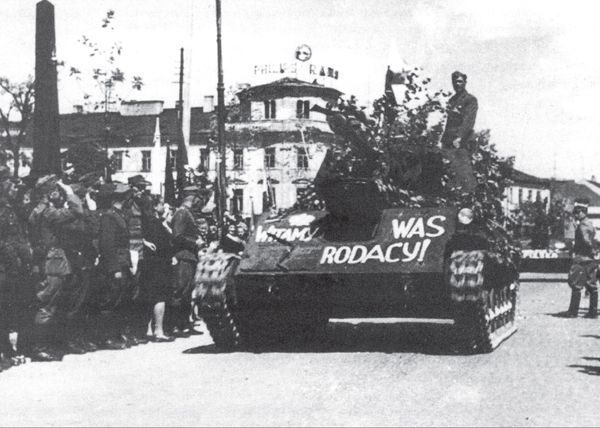
SU-76 assault-gun from the 1st Polish Army, summer 1944. (Leandoer & Ekholm archive)
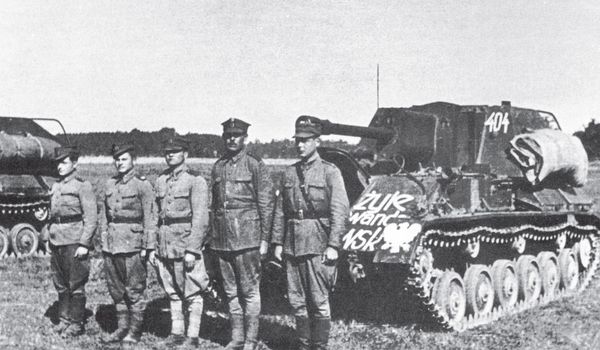
SU-76 serial no.404 belonging to the 4th SP Artillery Battalion, out of the 1st Polish Army, in the summer of 1944. The unit took part in the fighting for Praga. (Leandoer & Ekholm archive)
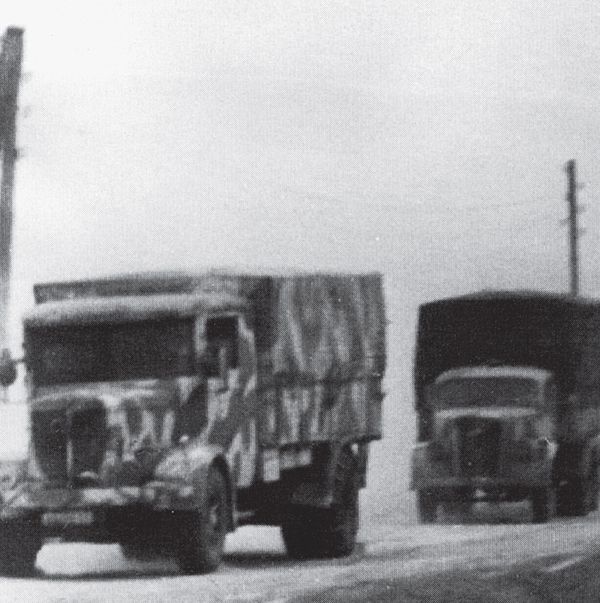
A long column of lorries from the 3rd SS-Panzer-Division “Totenkopf” passing along a dirt road in eastern Poland in the summer of 1944. The large dust bowls thrown up may give the impression that it is a winter scene. (Leandoer & Ekholm archive).

The Germans responded exactly as the STAVKA command had expected. The plan to successively broaden the front had been successfully demonstrated. It was only north of Belorussia that the Soviet side had time to attack before Heeresgruppe “Nord” had sent the majority of its reserves to its neighbouring Heeresgrupp's assistance. When the attacks of the Soviet's 2nd Baltic Front, 3rd Baltic Front and Leningrad Front took place, each in turn â precisely as planned, it forced the OKW to halt any further weakening of the Heeresgruppe fighting in the Baltic States. The course of battle on Latvian and Estonian territory was protracted, but the Soviet successes, reckoned in terms of total kilometres of occupied land, was insignificant when compared with the other line-sectors along the Eastern Front. In fact, a threat to the German troop line, and the possibility of it being split in the proximity of Riga, was already discerned by the Germans at the end of July, but that crisis they managed to overcome.
It wasn't until three months later that the Soviet troops cut off Heeresgruppe “Nord” in Kurland.
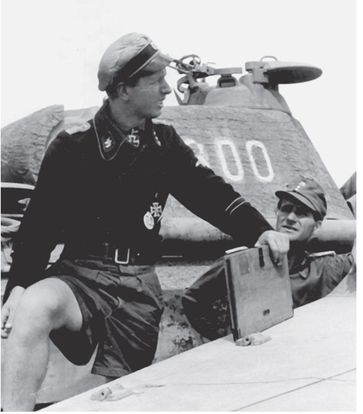
In all four pictures we find parts of SS-Panzer-Regiment 5 depicted while on the move behind the frontline during July 1944. Note that in the picture (bottom) on page 20, that the Panther's gun muzzle is covered for the purposes of rain protection as is the muzzle of the machine gun, hardly the case if they thought the enemy were nearby. Note the “clock” on the inside of the machine-gun shield on the half-track in the bottom picture on page 20. This assisted the gunner in orientating the direction toward the correct target to shoot at. The top picture on page 20 depicts a Panther marked 800, ditto bottom photo on page 21, this tank belonged to the commander of the 1st Company from Wiking's “Panther” Battalion. The half-track depicted on the right side bottom page 21, is a model Sd Kfz 250/3 and is a communication vehicle from the battalion command staff. In the top photo, page 21, we see a Panther, annotated 811, on the move with a couple of Sd Kfz 250/1s, probably part of one of the “Kampfgruppe” near the frontline; note the lack of rain protection on the muzzle. (Petter Kjellander)